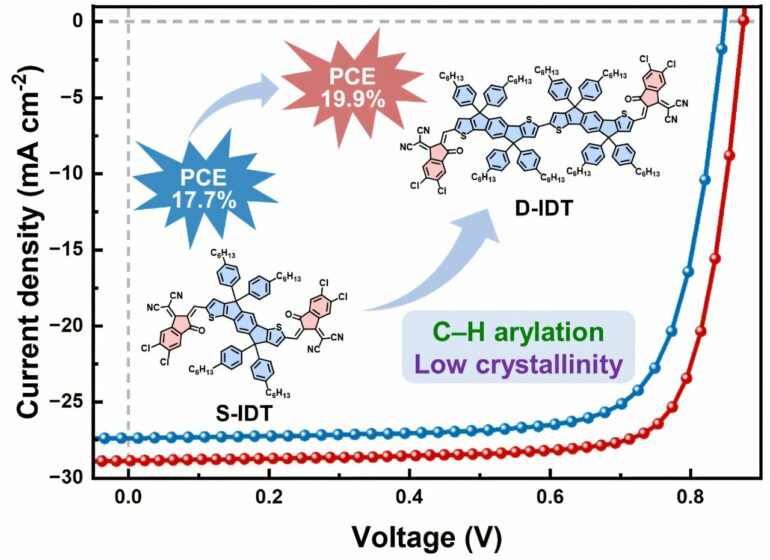A research team led by Prof. Ge Ziyi from the Ningbo Institute of Materials Technology and Engineering from the Chinese Academy of Sciences has developed a low-crystallinity guest acceptor, D-IDT, using a tin-free direct C–H activation method that they incorporated as a third component into binary organic solar cells (OSCs).
This finding resulted in a stable OSC with a power conversion efficiency (PCE) of 19.92%. The study is published in the journal Energy & Environmental Science.
OSCs have garnered considerable attention in the field of organic electronic devices due to their lightweight, mechanical flexibility, and translucency. However, the synthesis of organic photovoltaic materials for OSCs has traditionally relied on the Stille coupling reaction, which is plagued by complex procedures, high costs, and environmental concerns. As a result, there is a pressing need for more cost-effective and environmentally friendly synthesis methods.
To address this challenge, the research team designed and synthesized an A-D-D-A type guest acceptor, D-IDT, using a direct C–H activation approach. By employing a C–H/C–H cross-coupling strategy, the researchers simplified the synthesis process, achieving a high yield of 84%. When integrated into the D18:BTP-eC9 host system, D-IDT demonstrated superior π-conjugation but significantly weaker intermolecular interactions compared to the A-D-A type guest acceptor S-IDT.
The low crystallinity of D-IDT enhances its miscibility with the host acceptor BTP-eC9, promoting faster aggregation of BTP-eC9 and facilitating efficient exciton dissociation and charge transport. This results in a notable reduction in voltage loss, with the ternary device exhibiting a loss 18 mV lower than that of the binary system.
The ternary device incorporating D-IDT achieved a PCE of 19.92%, surpassing the 17.66% efficiency of devices based on S-IDT. This marks the highest efficiency reported to date for OSCs using the D18:BTP-eC9 host system. Furthermore, the D-IDT-treated OSCs demonstrated long-term stability, retaining 92% of their initial efficiency after 200 hours of continuous illumination.
This study highlights the potential of low-crystallinity guest acceptors in controlling crystallization kinetics and fine-tuning the assembly behavior of host acceptors. It provides new insights into the design of efficient third components through green and straightforward synthesis methods, bringing OSC technology closer to commercial viability.
More information:
Pengfei Ding et al, Direct C-H arylation-derived low crystallinity guest acceptor for high efficiency organic solar cells, Energy & Environmental Science (2025). DOI: 10.1039/D5EE00542F
Provided by
Chinese Academy of Sciences
Citation:
Novel synthesis method boosts efficiency of organic solar cells (2025, March 24)



